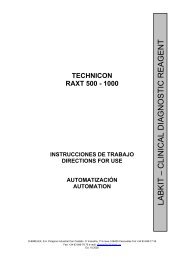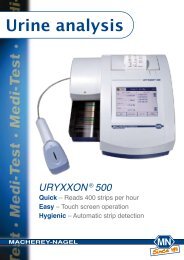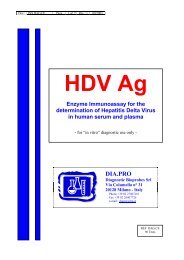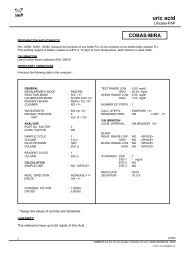[SAS-MX Acid Hb]. - Agentúra Harmony vos
[SAS-MX Acid Hb]. - Agentúra Harmony vos
[SAS-MX Acid Hb]. - Agentúra Harmony vos
- No tags were found...
Create successful ePaper yourself
Turn your PDF publications into a flip-book with our unique Google optimized e-Paper software.
<strong>SAS</strong>-<strong>MX</strong> ACID HB-10INTENDED PURPOSEThe <strong>SAS</strong>-<strong>MX</strong> <strong>Acid</strong> <strong>Hb</strong>-10 kit is intended for the separation of human haemoglobins by agarose gelelectrophoresis.Haemoglobins (<strong>Hb</strong>) are a group of proteins whose chief functions are to transport oxygen from thelungs to the tissues and carbon dioxide in the reverse direction. They are composed of polypeptidechains called globin, and iron protoporphyrin haem groups. A specific sequence of amino acidsconstitutes each of the four polypeptide chains. Each normal haemoglobin molecule contains one pairof alpha and one pair of non-alpha chains. In normal adult haemoglobin (<strong>Hb</strong>A), the non-alpha chainsare called beta. The non-alpha chains of foetal haemoglobin are called gamma. A minor (3%)haemoglobin fraction called <strong>Hb</strong>A 2 contains alpha and delta chains. Two other chains are formed in theembryo.The major haemoglobin in the erythrocytes of the normal adult is <strong>Hb</strong>A and there are small amounts of<strong>Hb</strong>A 2 and <strong>Hb</strong>F. In addition, over 400 mutant haemoglobins are now known, some of which may causeserious clinical effects, especially in the homozygous state or in combination with another abnormalhaemoglobin. Wintrobe 1 divides the abnormalities of haemoglobin synthesis into three groups.1. Production of an abnormal protein molecule (e.g. sickle cell anaemia).2. Reduction in the amount of normal protein synthesis (e.g. thalassaemia).3. Developmental anomalies (e.g. hereditary persistence of foetal haemoglobin (HPFH)).The two mutant haemoglobins most commonly seen are <strong>Hb</strong>S and <strong>Hb</strong>C. <strong>Hb</strong> Lepore, <strong>Hb</strong>E, <strong>Hb</strong>G-Philadelphia, <strong>Hb</strong>D-Los Angeles, and <strong>Hb</strong>O-Arab may be seen less frequently 2 .Electrophoresis is generally considered the best method for separating and identifyinghaemoglobinopathies. The protocol for haemoglobin electrophoresis involves step-wise use of twosystems 3-8 . Initial electrophoresis is performed in alkaline buffers. However, because of theelectrophoretic similarity of many structurally different haemoglobins, the evaluation must besupplemented by acid buffer electrophoresis which measures a property other than electrical charge.This method is based on the complex interactions of the haemoglobin with an acid electrophoreticbuffer and the agarose support. The <strong>SAS</strong>-<strong>MX</strong> <strong>Acid</strong> <strong>Hb</strong>-10 procedure is a simple procedure requiringminute quantities of haemolysate to provide complementary evidence (along with the results from<strong>SAS</strong>-<strong>MX</strong> Alk <strong>Hb</strong>-10 analysis) of the presence of <strong>Hb</strong>S, <strong>Hb</strong>C and <strong>Hb</strong>F as well as several other abnormalhemoglobins.WARNINGS AND PRECAUTIONSAll reagents are for in-vitro diagnostic use only. Do not ingest or pipette by mouth any kit component.Wear gloves when handling all kit components. Refer to the product safety data sheet for risk andsafety phrases and disposal information.1English


![[SAS-MX Acid Hb]. - Agentúra Harmony vos](https://img.yumpu.com/46129828/3/500x640/sas-mx-acid-hb-agentara-harmony-vos.jpg)

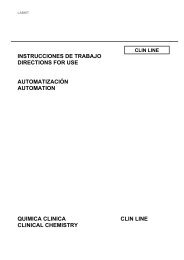
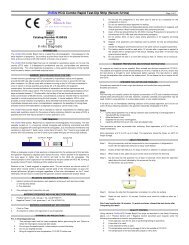
![[APTT-SiL Plus]. - Agentúra Harmony vos](https://img.yumpu.com/50471461/1/184x260/aptt-sil-plus-agentara-harmony-vos.jpg?quality=85)


![[SAS-1 urine analysis]. - Agentúra Harmony vos](https://img.yumpu.com/47529787/1/185x260/sas-1-urine-analysis-agentara-harmony-vos.jpg?quality=85)



